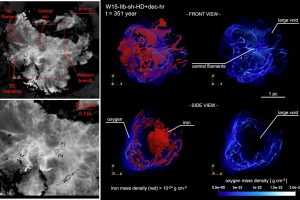Filaments in Cas A probe the processes occurred inside the progenitor during the explosion. The paper: “Filamentary ejecta network in Cassiopeia A reveals fingerprints of the supernova explosion mechanism” of S. Orlando (INAF-OAPA) appeared on A&A

A new theoretical study shows that the filamentary structure observed in the supernova remnant Cassiopeia A (Cas A) is a direct consequence of the processes that occurred in the progenitor star immediately after core collapse.
Supernovae are among the most energetic explosive events in the Universe. Yet, despite their immense brightness, they convert only about 1% of their energy into electromagnetic radiation. The remaining 99% is carried away by an intense flux of neutrinos, which can contain up to 10⁵⁸ particles. Although neutrinos interact very weakly with matter, numerous fundamental processes that occur in the minutes following core collapse—and before the shock wave emerges from the stellar surface—are actually driven by these elusive particles.
Since supernovae in the local Universe are rare events, the most effective way to investigate these processes is by studying supernova remnants and attempting to link their observed properties to the physical mechanisms of the explosion. The supernova remnant Cas A, located about 11,000 light-years from Earth and produced by a supernova that exploded around 350 years ago, represents an ideal natural laboratory for this type of study. Cas A was recently observed by the James Webb Space Telescope (JWST), which enabled an unprecedentedly detailed exploration of the remnant’s internal structure. The first results from these observations have already been published in scientific journals and shared through press releases.
Among the most striking structures revealed by JWST is a dense network of oxygen-rich filaments, resolved down to a scale of 0.03 light-years. A theoretical study—based on three-dimensional magnetohydrodynamic simulations that follow the evolution from stellar core collapse to a 1000-year-old supernova remnant—led by astrophysicist Salvatore Orlando (INAF – Palermo Astronomical Observatory), shows that this structure is directly linked to the processes that occurred in the progenitor star right after core collapse. In particular, the energy transferred by neutrinos produced during the collapse causes the formation of massive hot bubbles inside the star. As these bubbles expand, they deform the surrounding material layers, compressing and thinning them—especially those rich in oxygen, neon, and magnesium.
As the explosion progresses, the filament network takes shape as a result of hydrodynamic instabilities that develop during the shock wave’s propagation and the interaction between these compressed layers. In later stages, as the shock wave begins to travel through the circumstellar medium, the energy released from the decay of elements like nickel and cobalt into iron further increases the internal pressure in the remnant, compressing the overlying material and making the filaments even thinner and more well-defined.
The theoretical model also predicts the future evolution of these structures: the filaments will gradually be destroyed by interactions with reverse shock waves propagating inward through the supernova remnant over the next ~350 years.
The study is described in the paper “Filamentary ejecta network in Cassiopeia A reveals fingerprints of the supernova explosion mechanism“, recently appeared in the journal Astronomy & Astrophysics
Cover image (clickable link to view the full image).
The panels on the left show JWST images of Cas A, highlighting the network of filaments within the supernova remnant (Milisavljevic et al. 2024).
The panel on the right shows the distribution of iron- and oxygen-rich ejecta not yet reached by the shock wave, as derived from the simulations. In the left-hand panels, iron (Fe) is represented by a red 3D surface that highlights regions where the density exceeds a certain threshold. Oxygen-rich ejecta (O), on the other hand, are shown in the right-hand panels using a volumetric rendering in shades of blue, with intensity varying according to plasma density (indicated by the color scale in the bottom right). Denser areas appear more opaque, making the main structures easier to identify. The images present two different perspectives: the top panels show the supernova remnant as seen from Earth, while the bottom panels offer a side view, observed from a point located westward (along the positive x-axis). For an interactive experience, a navigable 3D model of the spatial distribution of oxygen and iron in Cas A is available at the following link: https://skfb.ly/psXKr.
Mario Giuseppe Guarcello
Follow MarioSpiegaCose on Instagram () , Facebook (), Youtube (), and X ()
Follow the Astronomical Observatory of Palermo on Facebok and on Instagram
Subscribe the Youtube channel of the Astronomical Observatory of Palermo
